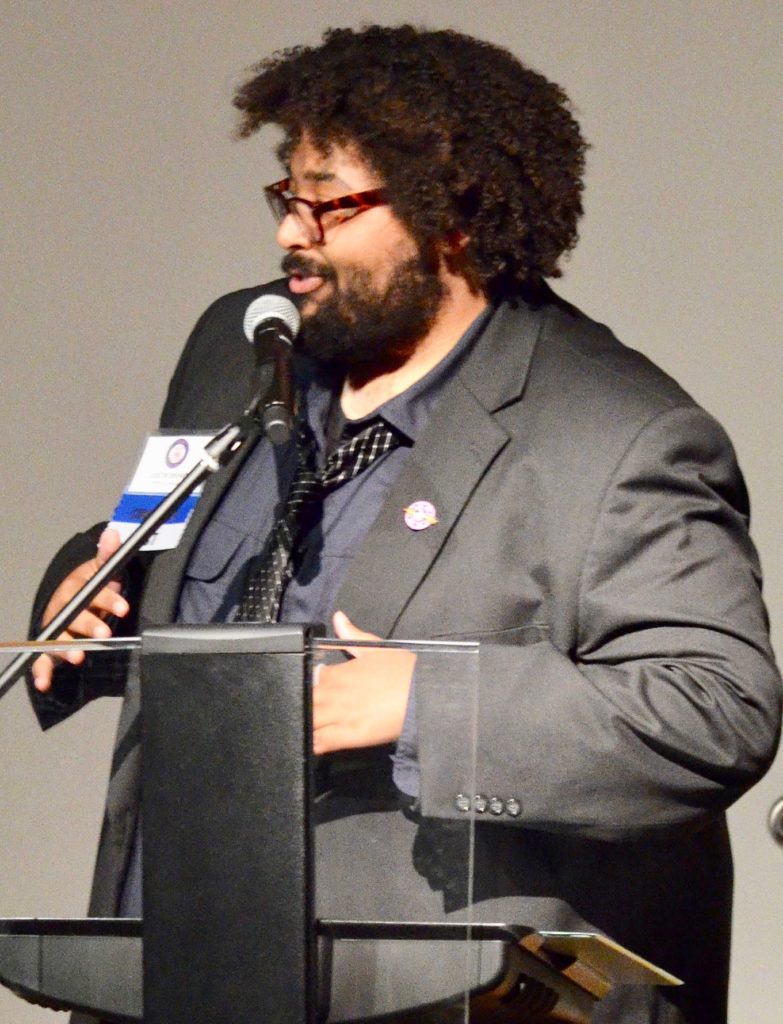Overview: Fifth Flint Youth Film Festival powered through the pandemic, thanks to teamwork and YouTube
By Patsy Isenberg
COVID-19 has thrown a big hit to performance arts and entertainment.
Visual arts are coming back, now that the FIA and galleries in the area have reopened. Theatre is the most challenging since audience members could wear masks and social distance in their seats but the performers need the freedom to interact with each other on stage. Recorded music continues and artists can still hold concerts if restrictions are put in place. Television is a much-needed distraction during our “stay at home” days and, as it’s turned out, months, but eventually new shows and episodes of people’s favorites won’t be available. Animation can still be done so we may see a barrage of animated movies and films soon.
Film, though, is mostly limited to TV broadcast and streaming, and lately the resurgence of drive-in theaters. But technology has developed to a point where creators of drama, comedy, documentaries and even reality TV have found ways to show their work.
 When the Flint Youth Film Festival geared up for its fifth year, everything was going along as usual until the pandemic happened. Some of the films were well underway or even finished by then, but several of the submissions clearly had a theme related to the pandemic. But the biggest problem was how to get the films seen. Normally a live audience would watch them at the FIA theatre and even the awards ceremony happened in front of a live audience.
When the Flint Youth Film Festival geared up for its fifth year, everything was going along as usual until the pandemic happened. Some of the films were well underway or even finished by then, but several of the submissions clearly had a theme related to the pandemic. But the biggest problem was how to get the films seen. Normally a live audience would watch them at the FIA theatre and even the awards ceremony happened in front of a live audience.
YouTube to the rescue!
Justin Brown of Flint was the director of the festival this year, the fifth. But he’s been involved since its inception by Rodney Brown, Justin’s father, and Donna Ullrich. Justin Brown had various roles for the first three years, was co-director in year four and then became full director this year.
His assistant director was Jessi Opperthauser who Brown said contributed a lot by “discussing ideas, getting the word out to entrants via email, and communicating with our team. She went above and beyond. One couldn’t ask for a better assistant director.” Opperthauser also co-hosted the award presentations with Brown on YouTube.

Justin Brown
When comparing screening in-person vs. online, Brown says, “I think there are merits for both. In-person, you can get a look at the audience who decided to come in on the day we offer to screen the films and get reactions to films and see if they match yours. Screening online you have more of an opportunity to reach people who may not have been able to make it to an in-person screening, but you also don’t get a chance to have that face to face interaction like you do with an in-person screening.”
But he said he feels that it wasn’t really more difficult to do the screening online. There were 1,278 views, and 354 viewers voted in the Audience Choice Award category.
Brown began his film making early. He first worked as a cameraperson on his dad’s independent projects. Then he began to create his own projects. He completed one short film that’s been featured in three film festivals and has others in development.
His own professional work goes under the name of Mophead Artistics. He lived in Baltimore while he studied to get his MFA in filmmaking from the Maryland Institute College of Art (MICA). He achieved that in 2019.
 He’s also busy wrapping up “unfinished business” for the Flint Youth Film Festival. He said one thing that has been somewhat difficult this year include “things we need to do to wrap up this year’s Festival and it’s things we usually would have had done if COVID weren’t a thing and we had our usual awards ceremony. But we’re almost done.”
He’s also busy wrapping up “unfinished business” for the Flint Youth Film Festival. He said one thing that has been somewhat difficult this year include “things we need to do to wrap up this year’s Festival and it’s things we usually would have had done if COVID weren’t a thing and we had our usual awards ceremony. But we’re almost done.”
Brown’s work on the festival overlapped his work on East Village Magazine’s “FACES of Flint: a message from the anvil of American democracy.” Brown did the editing on that project as well as several of his own Mophead Artistics projects in different stages of development.
Meanwhile, the youth festival films were judged by 12 professionals. Some were chosen from contacts given Brown by one of the previous directors and some of Brown’s young media associates. He said he thought it was “important to have the viewpoint of people who were closer to age with the entrants and that of people who have been around the block a few times and garnered some wisdom to go along with it.”
The judges were given only films from their particular area. One judge, Samantha Mitchell, is a documentary filmmaker, so she was given only non-fiction films to judge. She said the judges scored “different elements of the films on a numerical scale and then totaled the ratings into an overall score” with a possible 100. “Things like story and emotion were weighted more than technical perfection.” Mitchell attended MICA with Brown and now makes films for Johns Hopkins as well as producing independent films in Baltimore.
As described in EVM June 25. there were 32 films submitted and scored in three age groups. Numerous awards were given at the awards ceremony July 23. Among the big winners was “The Smile I Wear” by Antonio Corsi, who also won for another film, “The Most Desirable.” Another multiple winner was a nonfiction film, “Connecting Kin” by Olivia York from Jackson, Michigan.
Non fiction winner for cinematography in the 16-19 age group was “Ellie’s House/Charity Week” by Noah Scudder from Troy, Michigan. “Overgrown” by Corey Jarvinen from Byron, Michigan. Jarvinen received awards in the Audience Choice, Directing and Craft categories. The Audience Choice first place winner was “On Edge” by Geo Orlando from Flat Rock, Michigan, one of the younger filmmakers. The Heart Award was presented by Sen. Gary Peters. That award went to Olivia York’s “Connecting Kin.” The Heart Award goes to the film that displays the most passion for its subject.
There were also three awards given to Genesee County filmmakers this year. “The Hunt” by Ryan Blackwood of Linden received the youngest age category’s Achievement Award. Julien York of Flushing received an award in the PSA (public service award) category for “Keye PSA.” And Casey Iles from Clio received an award along with two co-filmmakers (Tessa Osborne and Celia Lochkos) for the highly original “The Moistest Museum.”
Cash prizes ranged from $100 to $300 each. Justin Brown said the prize amounts vary from year to year depending on the budget and how many winners there are. The Heart Award and The Audience Choice awards received the $300 prizes.
As a viewer of all 32 films myself, I had some favorites too, some of which won awards and some that didn’t. The skill level was impressive, but quite a few of the films had an element of fear, violence, and discontent. Could this be partly due to the events taking place in 2020? Only one film included a warning though. “Viewer discretion is advised” preceded the start of “Dogma 2025” by Merek Alam for its “disturbing imagery.” It was one of this viewers favorites. But the darker films were balanced by several that had heartfelt messages and wonderful humor such as “Connecting Kin” and “CoronApetite,” a film submitted by a Ali DeCesare from Greenwich, Rhode Island.
Brown said his “overall impression is that this is probably the best crop of films we’ve had in our five years of doing this festival.”
The films can still be viewed on the festival’s website.
EVM Staff writer and reviewer Patsy Isenberg can be reached at pisenber@gmail.com.


You must be logged in to post a comment.